

What are PFAS, and what are issues with them? Linda Gaines, Ph.D., P.E., BCEE OLEM/OSRTI/ARD/Science Policy Branch
Per- and Polyfluoroalkyl Substances • Group of thousands of chemicals – Subgrouped by functional groups – Most subgroups have range of chain lengths • Highly fluorinated • Highly resistant to degradation • Highly mobile • Varying (and unknown) levels of toxicity 1
PFAS • Perfluorotetradecanoic acid • Perfluoro(2-methyl-3-oxahexanoic) (PFTreA) acid (GenX) • Perfluorohexanesulfonic acid (PFHxS) • 4,8-dioxa-3H-perfluorononanoic acid (ADONA) • Fluorotelomer sulfonic acid 8:2 (FtS 8:2) • 8:2 Fluorotelomer phosphate diester (8:2 diPAP) 2
Pop Quiz: Which is PFOA? A B D C
What are PFAS used for? PFAS are used in a wide variety of industries and commercial products for their valuable properties, including fire resistance, dust suppression, and oil, stain, grease, and water repellence. • Fire fighting foams (AFFF) • Dust suppression for chrome plating • Food surfaces (Teflon) • Electronics manufacturing • Polishes, waxes, paints • Oil and mining for enhanced • Stain repellants on carpets and recovery upholstered furniture • Performance chemicals • Cleaning products (hydraulic fluid, fuel)
Overview of Potential PFAS Universe • Industries: • Waste disposal – Metal plating – Unlined landfills – Plastic and textile – land with biosolids coatings application – Chemical and plastics • AFFF users: manufacturing – Airports, train yards, etc. – Car washes – Fire training areas – Chemical refineries
PFAS Releases • Contamination routes vary – AFFF usage, testing, storage – groundwater, soil, wastewater – Biosolids application – soil to groundwater – Landfills – leachate to groundwater or wastewater – Manufacturing – wastewater and air deposition 6
PFAS Releases • PFAS found at sites: PFCA C4-14; PFSA C4-10; FtS 4:2, 6:2, 8:2; PFOSA, NEtFOSAA, NMeFOSAA • Media affected: – Groundwater – Soil – Surface water • Biota: fish, deer, honey 7
Toxicity Values and Health Advisories • RfD for PFOA and PFOS is 2x10e-5 mg/kg/d – Lifetime Drinking Water Health Advisory is 70 ppt – HA is based on sum of both PFOA and PFOS concentration • OW Oral Slope Factor of 0.07 (mg/kg-day)-1 for PFOA, but RfD is risk driver • PPRTV RfD for PFBS • Draft ATSDR MRL for PFOA, PFOS, PFNA, PFHxS • Various state toxicity values, risk levels, and standards
Toxicity and Risk • Risk = Toxicity x PFAS Author RfD (mg/kg day) PFOA OW 2.00E-05 Exposure PFOS OW 2.00E-05 • Some states use OW PFOA ATSDR (draft) 3.00E-06 PFOS ATSDR (draft) 2.00E-06 toxicity values in PFHxS ATSDR (draft) 2.00E-05 different exposure PFNA ATSDR (draft) 3.00E-06 equations PFBS PPRTV 2.00E-02 PFBS ORD (draft) 1.00E-02 • PFOA/PFOS/PFNA/PF HFPO-DA OW (draft) 8.00E-05 HxS similar toxicity; HFPO-DA NCDHHS 1.00E-04 PFBS less toxic
Current Analysis Methods • Method 537.1 for 18 PFAS in drinking water • ASTM Method 7979 single-lab validated for PFAS in non-potable waters using direct inject • ASTM Method 7968 single-lab validated for PFAS in soils using direct inject 10
Current Analysis Methods • Many commercial labs use Modified Method 537.1 for analysis. How is it modified? – A. Modified for other media – B. Modified for other analytes – C. Modified to use isotopic dilution – D. All of the above – E. Other – F. Yes? Maybe? 11
Analysis Methods in Progress • Draft SW-846 Method 8327 direct inject method for 24 PFAS in non-potable waters • Draft SW-846 Method 8328 solid phase extraction isotopic dilution method for 24 PFAS in non-potable waters and solids • Draft direct inject method for 24 PFAS in soils 12
Sampling • PFAS are ubiquitous so precautions must be taken to avoid contamination of samples • Existing wells may have PFAS leaching components which can cause contamination • Consideration needed of personal care products and clothing for potential contamination 13
Cleanup Challenges • Since PFAS are not CERCLA hazardous substance – cost recovery under CERCLA is not available – CERCLA authorities can be triggered if PFAS release or threat of release presents an imminent and substantial danger to public health or welfare (contaminant or pollutant) • No federal MCLs • Numerous states have derived different advisories and cleanup levels
Cleanup Challenges • Final toxicity information only for PFOA, PFOS, and PFBS • EPA Method 537.1 used for drinking water but no current multi-lab validated methods for other environmental media
Cleanup Challenges • Dispersion potential differs by type and length – Shorter seem to migrate faster – Migration depends on carbon content of soil – FtOH are volatile, but others can be dispersed by air as particulates • Ecological uptake differs – Animals seem to bioaccumulate sulfonates – Plants seem to uptake carboxylic acids 16
Cleanup Challenges • Water (drinking, ground, etc.) remediation – GAC – Ion exchange – Reverse Osmosis – Potential incompatibility with other contaminant remediation • Soil – Oxidation – Dig and haul 17
Questions? Gaines.linda@epa.gov
Recommend
More recommend